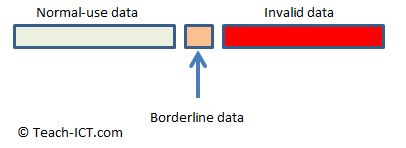3. Test data
We went over the idea of test data in our section on validating user inputs. The same idea can be applied to the program as a whole. Whilst writing the test plan, the 'test data' that is going to be used for each test, must be identified.
There are three types of test data :

1. Normal use data
This is the data that is expected to be entered into the application.
For example there may be an input form asking for a username. It is expected that the user will type in some letters and numbers for this. So normal use data will consist of usernames made of different combinations of letters and numbers.
The program needs to run without any errors when presented with this kind of data.
2. Borderline / Extreme data
This is testing the very boundary of acceptable data. Borderline data is still acceptable and it will be processed in the same way as normal data.
For example, the user is asked to enter a username with between 1 and 10 characters. The borderline test data would be a username with 1 character and a username with 10 characters.
Borderline data is excellent for testing the hard limits written into the software and that the application still runs properly when handling it.
3. Invalid / Erroneous data
This is data that the program rejects as invalid. That might be because it is the wrong data type. It might be because it contains characters that are not allowed. Or it may be that the value falls outside the accepted parameters of the program.
For example, if the user is asked to enter a username with between 1 and 10 characters, invalid test data would be a blank username, or a username with 13 characters, or one that does not use standard letters and numbers (emojis or foreign characters, for example).
If invalid data is presented, then the application needs to handle it properly i.e. not crash. Usually the user is told that the data provided has been rejected.
Challenge see if you can find out one extra fact on this topic that we haven't already told you
Click on this link: Types of test data
